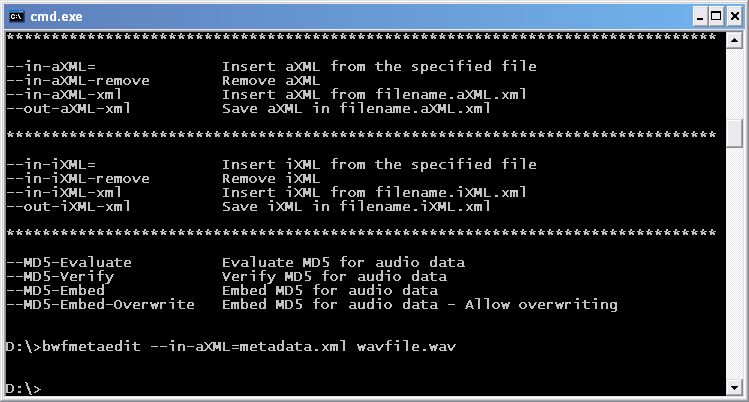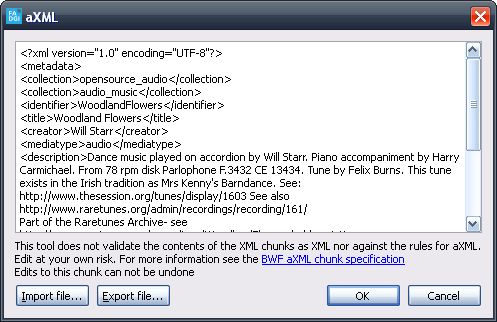Embedding XML data using BWFMetaEdit
introduction
BWFMetaEdit was developed by the Federal Agencies Digitization Guidelines Initiative (FADGI) supported by AudioVisual Preservation Solutions. This tool permits embedding, editing, and exporting of metadata in Broadcast WAVE Format (BWF) files. This tool can also enforce metadata guidelines developed by the Federal Agencies Audio-Visual Working Group, as well as recommendations and specifications from the European Broadcasting Union (EBU), Microsoft, and IBM.
The EBU BWF specification states that "The <axml> chunk may contain any data compliant with the XML 1.0 format or later". The notes which follow describe embedding metadata using non standard XML format, embedding geo-spatial data using KML, embedding playlist information using XSPF, and embedding musical notation using musicXML.
Embedding XML data
XML data can be embedded using either the GUI or Command Line version of BWFMetaEdit

For further details view BWFMetaEdit documentation, or type "BWFMetaEdit --help" at the command line.
Examples
Internet Archive XML metadata
Two of the files used in these examples were sourced using the Internet Archive 78rpm & Cylinder Recording Collection. These recordings are accompanied by metadata in a simple XML format. Data includes collection, title, description, copyright and other details. In this first example the XML data is embedded without change.
This first recording is of Scottish Accordion Player Will Starr playing Woodland Flowers. The recording is available in various formats including mp3 and wav files. XML metadata is also available.
The wav file with embedded metadata can be downloaded by following this link.
XML data embedded in this file can be seen displayed using BWFMetaEdit in the screen shot below.

KML
The audio in this example was digitized from an unreleased 78rpm disc recorded in Glasgow c.1948. The disc is from a private collection. Ownership is not defined for these recordings and for that reason is not available for download here.
The typewritten disc label includes the address of the recording studio. This geo-spatial data has be embedded with latitude and longitude co-ordinates using KML. Keyhole Markup Language (KML) is an XML notation for expressing geographic annotation and visualization within Internet-based, two-dimensional maps and three-dimensional Earth browsers. Many applications display KML, including Google Earth, Google Maps, Google Maps for mobile, NASA WorldWind, ESRI ArcGIS Explorer, Adobe PhotoShop, AutoCAD, and Yahoo! Pipes.
<?xml version="1.0" encoding="UTF-8"?> <kml xmlns="http://www.opengis.net/kml/2.2"> <Placemark> <name>Hall & Barrie - Recording Studios</name> <description> <![CDATA[ <address>15 Broompark Drive,<br/> DENNISTOUN, GLASGOW.<br/> <br/> Telephone; BRIdgeton 1202 </address> ]]> </description> <Point> <coordinates>-4.22472,55.861237,0</coordinates> </Point> </Placemark> </kml>
The KML file is available here and can be viewed on Google maps here.
XSPF
This third example is also sourced from the Internet Archive 78rpm & Cylinder Recording Collection. The recording recording features Scottish fiddler Sydney Chalmers playing Bonnie Anne, Glen Grant Strathspey and Left Handed Fiddler. As before the recording is available in a variety of formats including wav and mp3. Metadata has been taken from the the Internet Archive XML source and mapped to the XML playlist format XSPF. The XSPF format is recognised by a wide variety of media players. In this instance the track data references an online mp3 version of the recording and also includes web links and a jpeg image reference.
<?xml version="1.0" encoding="UTF-8"?> <playlist version="1" xmlns="http://xspf.org/ns/0/"> <trackList> <track> <creator>Sydney Chalmers</creator> <title>http://www.raretunes.org/recordings/sydchalmers1/</title> <annotation> From an unidentified 78 rpm disk on a cassette tape provided by Ian Grant. Since identified as Parlophone R.4089 CE 15408. Piano accompaniment by Norman A. Whitelaw. </annotation> <location>http://media.raretunes.org/sydchalmers1_vbr.mp3</location> <image>http://www.raretunes.org/static/artists/sydchalmers3.jpg</image> <info>http://www.raretunes.org/recordings/sydchalmers1/</info> </track> </trackList> </playlist>
Download the XSPF file here and download the wav file with embedded metadata here.
musicXML
This final example is also drawn from a private collection. The recording was digitized from a 78rpm disc recording of Scottish accordion player William Hannah playing the Duke of Perth.
The recorded was transcribed using abc notation. This text based notation is widely used by traditional and folk musicians. File sizes are small and are easily transfered over the Internet. They are easily displayed as standard notation and can be exported as jpg, gif, postscript and pdf files.
![William Hannah - Duke of Perth[score]](William Hannah - Duke of Perth[score].jpg)
X:1 T:Duke of Perth M:4/4 L:1/8 K:G B|G/A/B/c/dB gBdB|gBdB aAAB|G/A/B/c/dB gBdB|cAdc BGG:|! f|g>age a>baf|g>age beef|g>age a>baf|gde>c BGG:|!
The abc notation was converted to musicXML using the online abc to musicXML converter. The resulting XML was embedded in the source wav file.
Download the musicXML file here and the abc file here.
Other XML formats
The above examples are put forward to demonstrate the possibilities for embedding data to support and enhance audio content. Other XML data formats that could be used would include voiceXML, OAI, PNDS-DCAP, SMIL, RSS and GeoRSS.
Links
- BWFMetaEdit
- aXML
- bwf
- Technology Watch Report 09-01: Preserving Geospatial Data [PDF 692KB], by Guy McGarva, Steve Morris and Greg Janée 2009
- Technology Watch Report 05-01: Preservation Metadata (PDF 209KB) by Brian Lavoie and Richard Gartner 2005
- FADGI
Mike Hirst
22:01 24 May 2011